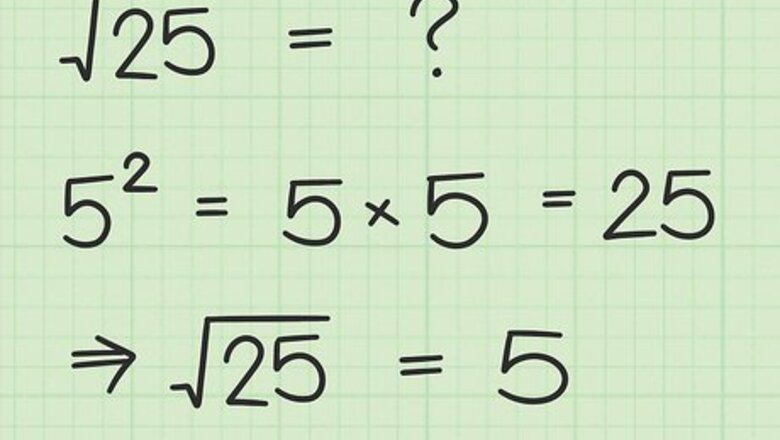
views
Understanding Squares and Square Roots
Square a number by multiplying it by itself. To understand square roots, it's best to start with squares. Squares are easy—taking the square of a number is just multiplying it by itself. For instance, 3 squared is the same as 3 × 3 = 9 and 9 squared is the same as 9 × 9 = 81. Squares are written by marking a small "2" above and to the right of the number being squared — like this: 3, 9, 100, and so on. Try squaring a few more numbers on your own to test this concept out. Remember, squaring a number is just multiplying it by itself. You can even do this for negative numbers. If you do, the answer will always be positive. For example, (-8) = -8 × -8 = 64.
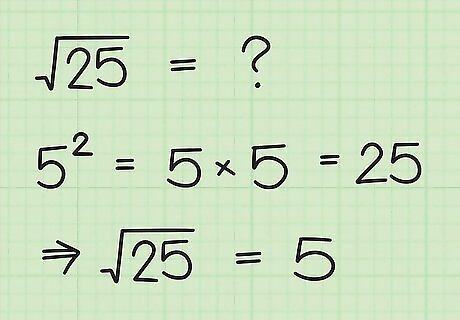
For square roots, find the "reverse" of a square. The square root symbol (√, also called a "radical" symbol) means basically the "opposite" of the symbol. When you see a radical, you want to ask yourself, "what number can multiply by itself to give the number under the radical?" For instance, if you see √(9), you want to find the number that can be squared to make nine. In this case, the answer is three, because 3 = 9. As another example, let's find the square root of 25 (√(25)). This means we want to find the number that squares to make 25. Since 5 = 5 × 5 = 25, we can say that √(25) = 5. You can also think of this as "undoing" a square. For example, if we want to find √(64), the square root of 64, let's start by thinking of 64 as 8. Since a square root symbol basically "cancels out" a square, we can say that √(64) = √(8) = 8.
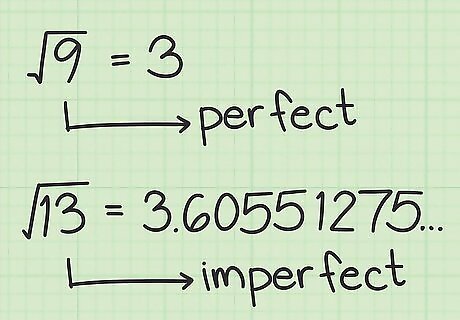
Know the difference between perfect and imperfect squares. Up until now, the answers to our square root problems have been nice, round numbers. This isn't always the case — in fact, square root problems can sometimes have answers that are very long, inconvenient decimals. Numbers that have square roots that are whole numbers (in other words, numbers that aren't fractions or decimals) are called perfect squares. All of the examples listed above (9, 25, and 64) are perfect squares because when we take their square roots, we get whole numbers (3, 5, and 8). On the other hand, numbers that don't give whole numbers when you take their square roots are called imperfect squares. When you take one of these numbers' square roots, you usually get a decimal or fraction. Sometimes, the decimals involved can be quite messy. For instance, √(13) = 3.605551275464...
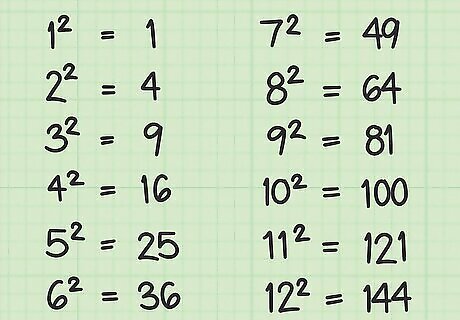
Memorize the first 10-12 perfect squares. As you've probably noticed, taking the square root of perfect squares can be quite easy! Because these problems are so simple, it's worth your time to memorize the square roots of the first dozen or so perfect squares. You'll come across these numbers a lot, so taking the time to learn them early can save you lots of time in the long run. The first 12 perfect squares are: 1 = 1 × 1 = 1 2 = 2 × 2 = 4 3 = 3 × 3 = 9 4 = 4 × 4 = 16 5 = 5 × 5 = 25 6 = 6 × 6 = 36 7 = 7 × 7 = 49 8 = 8 × 8 = 64 9 = 9 × 9 = 81 10 = 10 × 10 = 100 11 = 11 × 11 = 121 12 = 12 × 12 = 144
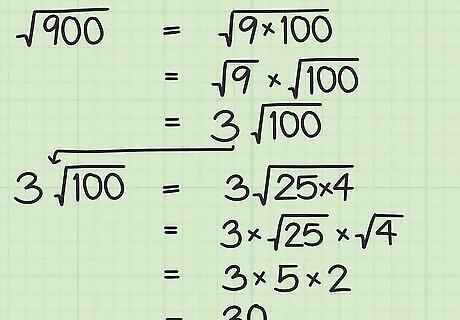
Simplify square roots by removing perfect squares when possible. Finding the square roots of imperfect squares can sometimes be a bit of a pain — especially if you're not using a calculator (in the sections below, you'll find tricks for making this process easier). However, it's often possible to simplify the numbers in square roots to make them easier to work with. To do this, you simply need to separate the number under the radical into its factors, then take the square root of any factors that are perfect squares and write the answer outside the radical. This is easier than it sounds — read on for more information! Let's say that we want to find the square root of 900. At first glance, this looks very difficult! However, it's not hard if we separate 900 into its factors. Factors are the numbers that can multiply together to make another number. For instance, since you can make 6 by multiplying 1 × 6 and 2 × 3, the factors of 6 are 1, 2, 3, and 6. Instead of working with the number 900, which is somewhat awkward, let's instead write 900 as 9 × 100. Now, since 9, which is a perfect square, is separated from 100, we can take its square root on its own. √(9 × 100) = √(9) × √(100) = 3 × √(100). In other words, √(900) = 3√(100). We can even simplify this two steps further by dividing 100 into the factors 25 and 4. √(100) = √(25 × 4) = √(25) × √(4) = 5 × 2 = 10. So, we can say that √(900) = 3(10) = 30.
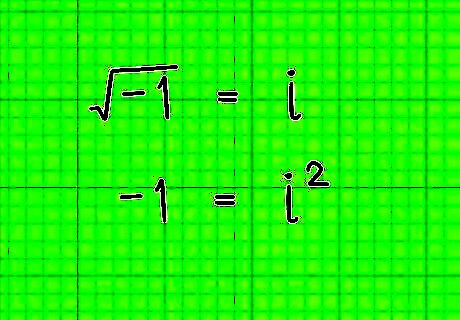
Use imaginary numbers for the square roots of negative numbers. Think — what number times itself equals -16? It's not 4 or -4 — squaring either of these gives positive 16. Give up? In fact, there isn't a way to write the square root of -16 or any other negative number with ordinary numbers. In these cases, we have to substitute imaginary numbers (usually in the form of letters or symbols) to take the place of the negative number's square root. For example, the variable "i" is usually used for the square root of -1. As a general rule, the square root of a negative number will always be an imaginary number (or include one). Note that although imaginary numbers can't be represented with ordinary digits, they can still be treated like ordinary numbers in many ways. For instance, the square roots of negative numbers can be squared to give those negative numbers, just like any other square root. For example, i = -1
Using Long Division-Style Algorithms
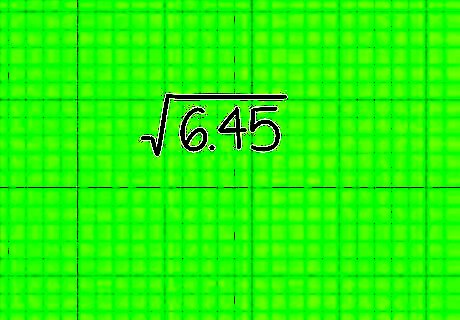
Arrange your square root problem like a long division problem. Though it can be a little time-consuming, it's possible to solve for the square roots of difficult imperfect squares without a calculator. To do this, we'll use a solving method (or algorithm) that's similar — but not exactly the same — as basic long division. Start by writing out your square root problem in the same from as a long division problem. For example, let's say that we want to find the square root of 6.45, which is definitely not a convenient perfect square. First, we'd write an ordinary radical symbol (√), then we'd write our number underneath it. Next, we'd make a line above our number so that it's in a little "box" — just like in long division. When we're done, we should have a long-tailed "√" symbol with 6.45 written under it. We'll be writing numbers above our problem, so be sure to leave space.
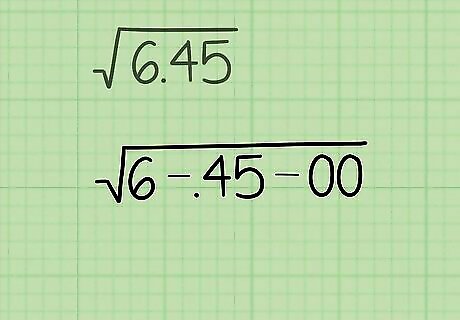
Group digits into pairs. To start solving your problem, group the digits of the number under the radical sign into pairs, starting at the decimal point. You may want to make small marks (like dots, slashes, commas, etc.) between your pairs to keep track of them. In our example, we would divide 6.45 into pairs like this: 6-.45-00. Note that there is a "leftover" digit on the left — this is OK.
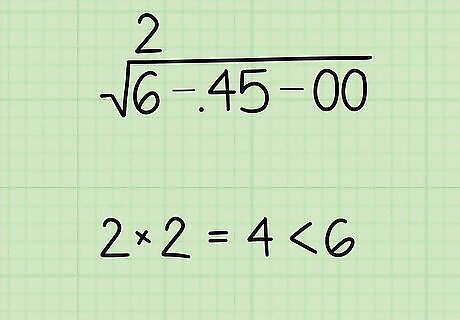
Find the biggest number whose square is less than or equal to the first "group". Start with the first number or pair on the left. Pick the biggest number with a square that is less than or equal to the "group". For instance, if the group was 37, you would pick 6, because 6 = 36 < 37 but 7 = 49 > 37. Write this number above the first group. This is the first digit of your answer. In our example, the first group in 6-.45-00 is 6. The biggest number that is less than or equal to 6 when squared is 2 — 2 = 4. Write a "2" above the 6 under the radical.
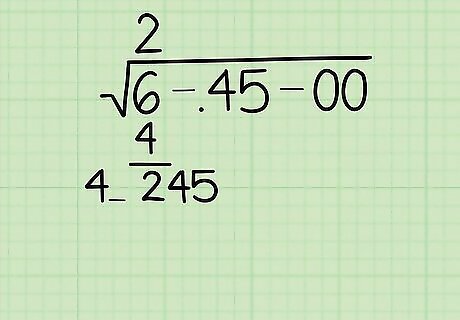
Double the number you just wrote down, then drop it down and subtract it. Take the first digit of your answer (the number you just found) and double it. Write this underneath your first group and subtract to find the difference. Drop the next pair of numbers down beside the answer. Finally, write the last digit of the double of the first digit of your answer to the left and leave a space next to it. In our example, we would start by taking the double of 2, the first digit of our answer. 2 × 2 = 4. Next, we would subtract 4 from 6 (our first "group"), getting 2 as our answer. Next, we would drop down the next group (45) to get 245. Finally, we would write 4 once more to the left, leaving a small space to add onto the end, like this: 4_.
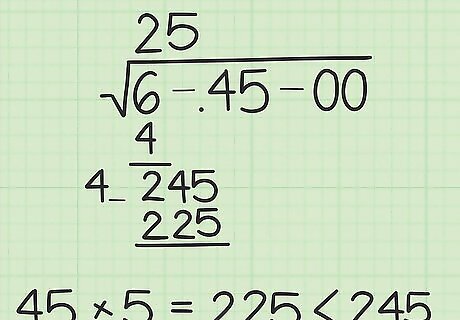
Fill the empty space. Next, you want to add a digit to the right side of the number you've written off to the left. Pick the digit that multiplies with your new number to be as large as possible, yet still less than or equal to the "dropped down" number. For example, if your "dropped down" number is 1700 and your number to the left is 40_, you would fill in the blank with "4" because 404 × 4 = 1616 < 1700, while 405 × 5 = 2025. The number you find in this step is the second digit of your answer, so you can add it above the radical sign. In our example, we want to find the number to fill in the blank in 4_ × _ that makes the answer as large as possible but still less than or equal to 245. In this case, the answer is 5. 45 × 5 = 225, while 46 × 6 = 276.
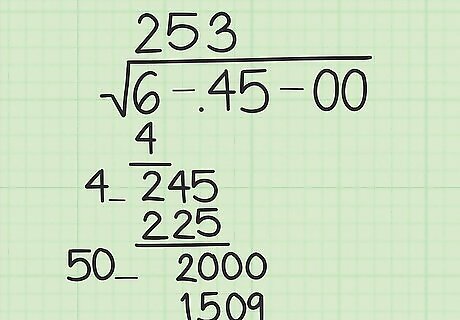
Continue, using your "blank" numbers for your answer. Continue performing this modified long division pattern until you start getting zeroes when you subtract from your "dropped-down" number or you reach your desired level of accuracy. When you're done, the numbers you used to fill the blanks at each step (plus the very first number you used) make up the digits in your answer. Continuing from our example, we would subtract 225 from 245 to get 20. Next, we would drop down the next pair of digits, 00, to make 2000. Doubling the numbers above the radical sign, we get 25 × 2 = 50. Solving for the blank in 50_ × _ =/< 2,000, we get 3. At this point, we have "253" above the radical sign — repeating this process once again, we get a 9 as our next digit.
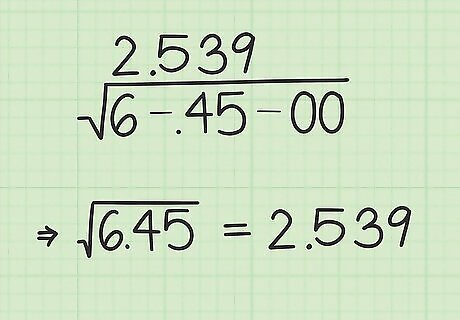
Move the decimal point up from your original "dividend". To finalize your answer, you need to put its decimal point in the right place. Luckily, this is easy — all you need to do is line it up with the decimal point in your original number. For example, if the number under the radical sign is 49.8, you would simply move the point up between the two numbers above the 9 and the 8. In our example, the number under the radical sign is 6.45, so we would simply slide the point up and place it between the 2 and 5 digits of our answer, giving us 2.539.
Quickly Estimating Imperfect Squares
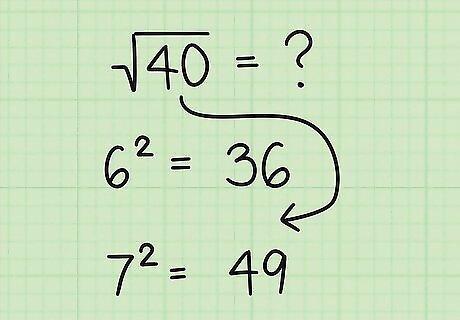
Find non-perfect squares by estimating. Once you've memorized your perfect squares, finding the square roots of imperfect squares becomes much easier. Since you already know a dozen or so perfect squares, any number that falls between two of these perfect squares can be found by "whittling away" at an estimate between these values. To start, find the two perfect squares your number is between. Next, determine which of these two numbers it is the closest to. For example, let's say we need to find the square root of 40. Since we've memorized our perfect squares, we can say that 40 is in between 6 and 7, or 36 and 49. Since 40 is greater than 6, its square root will be greater than 6, and since it is less than 7, its square root will be less than 7. 40 is a little closer to 36 than it is to 49, so the answer will probably be a little closer to 6. In the next few steps, we'll narrow our answer down.
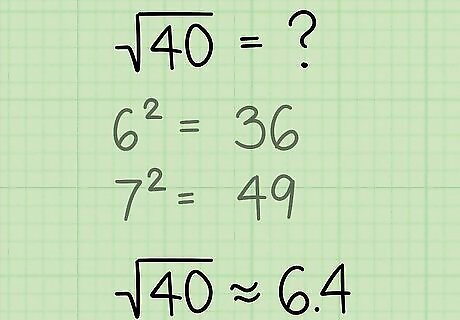
Estimate the square root to one decimal point. Once you've picked out two perfect squares that your number is between, it's simply a matter of whittling away at your estimate until you reach an answer you're satisfied with — the farther you go, the more accurate your answer is. To start, pick a "tenth place" decimal point for your answer — it doesn't have to be correct, but you'll save time if you use common sense to pick one that's close to the right answer. In our example problem, a reasonable estimate for the square root of 40 might be 6.4, since we know from above that the answer is probably a little closer to 6 than it is to 7.
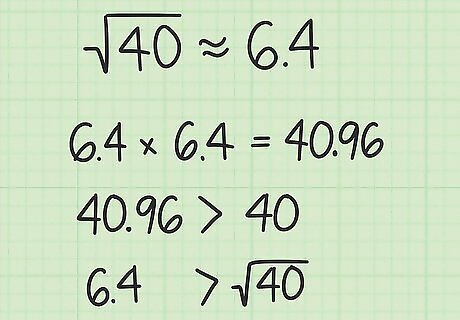
Multiply your estimate by itself. Next, square your estimate. Unless you're lucky, you probably won't get your original number — you'll either be a little higher than it or a little lower. If your answer is too high, try again with a slightly smaller estimate (and vice versa if it is too low). Multiply 6.4 by itself to get 6.4 × 6.4 = 40.96, which is slightly higher than original number. Next, since we over-shot our answer, we'll multiply the number one tenth less than our estimate above by itself and to get 6.3 × 6.3 = 39.69. This is slightly lower than our original number. This means that the square root of 40 is somewhere between 6.3 and 6.4. Additionally, since 39.69 is closer to 40 than 40.96, you know the square root will be closer to 6.3 than 6.4.
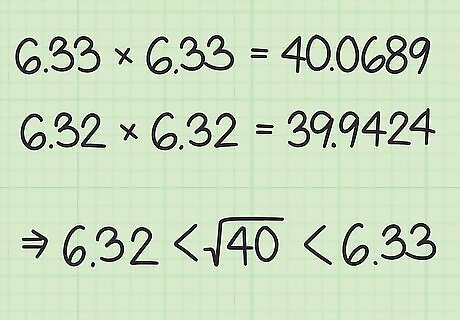
Continue estimating as needed. At this point, if you're happy with your answers, you may want to simply use one of your first guesses as an estimate. However, if you'd like a more accurate answer, all you need to do is pick an estimate for your "hundredths place" that puts this estimate between your first two. Continuing with this pattern, you can get three decimal places for your answer, four, and so on — it just depends how far you want to go. In our example, let's pick 6.33 for our two-decimal point estimate. Multiply 6.33 by itself to get 6.33 × 6.33 = 40.0689. Since this is slightly above our original number, we'll try a slightly lower number, like 6.32. 6.32 × 6.32 = 39.9424. This is slightly below our original number, so we know that the exact square root is between 6.33 and 6.32. If we wanted to continue, we would keep using this same approach to get an answer that's continually more and more accurate.

















Comments
0 comment